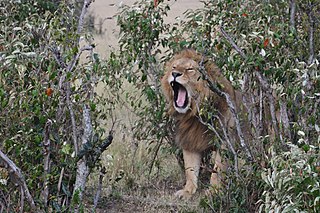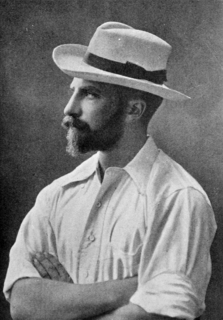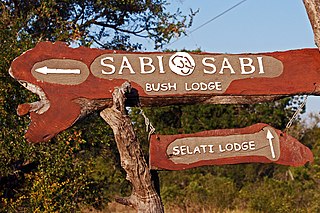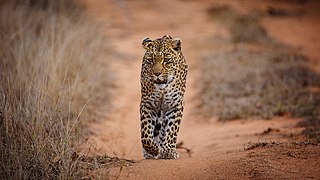
Kruger National Park is a South African National Park and one of the largest game reserves in Africa. It covers an area of 19,623 km2 (7,576 sq mi) in the provinces of Limpopo and Mpumalanga in northeastern South Africa, and extends 360 km (220 mi) from north to south and 65 km (40 mi) from east to west. The administrative headquarters are in Skukuza. Areas of the park were first protected by the government of the South African Republic in 1898, and it became South Africa's first national park in 1926.

Zimbabwe Parks and Wildlife Management Authority (Zimparks) is an agency of the Zimbabwe government managing national parks. Zimbabwe's game reserves are managed by the government. They were initially founded as a means of using unproductive land.

Nairobi National Park is a national park in Kenya that was established in 1946 about 7 km (4.3 mi) south of Nairobi. It is fenced on three sides, whereas the open southern boundary allows migrating wildlife to move between the park and the adjacent Kitengela plains. Herbivores gather in the park during the dry season. Nairobi National Park is negatively affected by increasing human and livestock populations, changing land use and poaching of wildlife. Despite its proximity to the city and its relative small size, it boasts a large and varied wildlife population, and is one of Kenya's most successful rhinoceros sanctuaries.

James Stevenson-Hamilton served from 1902–1946 as the first warden of South Africa's Sabi Nature Reserve, which was expanded under his watch and became Kruger National Park in 1926. The Tsonga people nicknamed him Skukuza because when he arrived at the area of the reserve he "turned everything upside down" with the banning of all hunting in the reserve and the relocation of all the native kraals. Skukuza camp and Skukuza Airport is named in honour of Stevenson-Hamilton, who is regarded as a champion of wildlife Conservation in South Africa.

Great Limpopo Transfrontier Park is a 35,000 km² peace park that is in the process of being formed. It will link the Limpopo National Park in Mozambique, Kruger National Park in South Africa, Gonarezhou National Park, Manjinji Pan Sanctuary and Malipati Safari Area in Zimbabwe, as well as the area between Kruger and Gonarezhou, the Sengwe communal land in Zimbabwe and the Makuleke region in South Africa.

Mala Mala is a game reserve located within the Sabi Sand Game Reserve, Mpumalanga province, South Africa. It is the largest and the oldest private big five game reserve in South Africa, It covers around 130 km2 or 15 000 hectares of land. In Xitsonga, the name Malamala means Kudu, it was named so because of the abundance of these animals within the game reserve. The Tsonga people, who occupied the land before the establishment of the game reserve, were forcibly removed from this land during the early 1900s and were dumped at Bushbuckridge. The Nwandlamhlarhi Community successfully claimed Malamala game reserve and the land was restored to them in 2015 when President Jacob Zuma handed them their land in a Government ceremony. The Tsonga people were also forcibly removed from neighbouring game reserves such as Skukuza, Satara, Ulusaba, Manyeleti, Protea Hotel Kruger Gate, Hoyo Hoyo Tsonga Lodge and may more in Southern Kruger. The Tsonga people are still waiting to be given back these lands by the Government after the finalization of their land claim.

Sabi Sabi is a private game reserve in South Africa, situated in the Sabi Sand Game Reserve which flanks the south western section of the Kruger National Park. The Sabi Sand Reserve is one of the parks that make up the Greater Kruger National Park.

Sioma Ngwezi National Park is a 5,000-square-kilometre park in the south west corner of Zambia. It is undeveloped and rarely visited, lacking roads and being off the usual tourist tracks, but this may change in the future.

The Timbavati Private Nature Reserve is located at the border line between Hoedspruit and Acornhoek, north of the Sabi Sand Private Game Reserve on the western edge of Kruger National Park. Geographically and politically, Timbavati is located in Mpumalanga Province. In Xitsonga, the name 'Timbavati' means "the place where something sacred came down to Earth from the Heavens", and refers to the rare white lions of Timbavati.

Thuli Parks and Wildlife Land is a protected area in south-western Zimbabwe. It comprises four areas within the Zimbabwe Parks and Wildlife Estate and covers the entire west bank of the Shashe River within the Thuli Circle.

Mapungubwe National Park is a national park in Limpopo Province, South Africa. It is located by the Kolope River, south of the confluence of the Limpopo and Shashe rivers and about 15 kilometres (9.3 mi) to the NE of the Venetia Diamond Mine. The National Park borders Mapesu Private Game Reserve to the south. It abuts on the border with Botswana and Zimbabwe, and forms part of the Greater Mapungubwe Transfrontier Conservation Area. It was established in 1995 and covers an area of over 28,000 hectares. The park protects the historical site of Mapungubwe Hill, which was the capital of the Kingdom of Mapungubwe, as well as the wildlife and riverine forests along the Limpopo River. The Mapungubwe Hill was the site of a community dating back to the Iron Age. Evidences have shown that it was a prosperous community. Archaeologists also uncovered the famous golden rhino figurine from the site. It is one of the few places in Africa that has both meerkats and Nile crocodiles.
The Mpumalanga Tourism and Parks Agency (MTPA) Board is a governmental organisation responsible for maintaining wilderness areas and public nature reserves in Mpumalanga Province, South Africa.

Balule Nature Reserve is a protected area in Limpopo Province, South Africa which forms part of the Greater Kruger National Park as a member of the Associated Private Nature Reserves (APNR). As part of a wildlife conservation initiative, all fences separating APNR reserves – Balule, Timbavati, Klaserie, Umbabat, Grietjie Private Nature Reserve – and the Kruger National Park have been removed. The ecological benefits of this initiative has made the region a popular ecotourism destination and conservation efforts have ensured that the wildlife population includes all of the Big Five game: lion, African bush elephant, African buffalo, African leopard and black rhinoceros.
Lion Sands Private Game Reserve, also known as Lion Sands Reserve, was established in 1933 by Guy Aubrey Chalkley, and forms part of the Sabi Sands Private Game Reserve as well as the Kruger National Park, which together with some other parks make up the Greater Kruger National Park in South Africa.

Ulusaba Private Game Reserve, owned by Sir Richard Branson as part of the Virgin Limited Edition luxury property portfolio, consists of about 13,500 ha of land set in the heart of the Sabi Sand Private Game Reserve. This private game reserve borders on the sprawling Kruger National Park in South Africa's Mpumalanga province and is home to an abundance of wildlife. Ulusaba means fearful in the local Tsonga (Shangaan) language and it was a name given to the Sabie River by the Shangaan people. The Sabie River was originally called Ulusaba by the Shangaan simply because there was once a large concentration of dangerous Nile crocodile in the river. Before the establishment of the Kruger National Park, Ulusaba was once a home of Tsonga-Shangaan people, the Shangaan were evicted from this land when the Kruger National Park was established and were relocated in nearby villages adjacent Ulusaba Private Game Reserve.
The Kruger National Park is a South African National Park and one of the largest game reserves in Africa. Originally known as The Sabi Game Reserve, it became a game reserve in 1898. The park became known as Kruger National Park in 1926, when it was named after Paul Kruger.

Sabi Sand Game Reserve is located adjacent to the Kruger National Park in the Lowveld of Mpumalanga, South Africa. Officially named Sabi Sand Wildtuin, the Sabi Sand Game Reserve consists of a group of private game reserves. The Newington Gate is at 24°52′9″S31°24′16″E and west of the Kruger Gate and Skukuza camp of Kruger Park. Other entrances are Gowrie Gate in the far north and Shaws Gate in the south.

The Laohu Valley Reserve (LVR) is a nature reserve located near Philippolis in the Free State and near Vanderkloof Dam in the Northern Cape of South Africa. It is a roughly 350-square-kilometre private reserve.
The Mapogo lion coalition was a band of male South African lions that controlled the Sabi Sand region in Kruger National Park. The coalition became infamous for their sheer power and strength in taking over and dominating an area of approximately 70,000 ha. It is believed the Mapogos killed in excess of 100 lions and cubs in a little over a year. The statistics may be higher given their coverage of such large territories. At its peak, the coalition consisted of six males - the leader Makulu, Rasta, Scar, Pretty Boy, Kinky Tail and Mr. T.
















